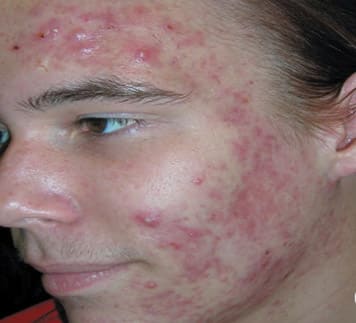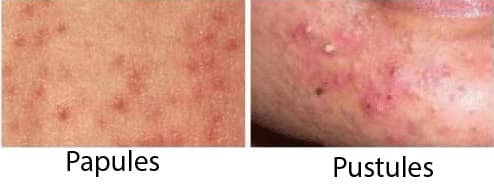What is acne
Inflammation of the sebaceous (oil) glands is known as acne. Sebaceous glands are connected to hair follicles in the skin. At first, there is excessive sebum production due to the action of androgen, which is a hormone produced in both females and males.
These glands become blocked (blackheads and whiteheads) due to increased keratinization of the sebaceous duct. Normal harmless bacteria that live on the skin can contaminate and infect the blocked hair follicles, which give rise to papules, pustules, or nodules.

Different Types of Acne
- Infantile
- This occurs in the first few months of life, mainly on the face. Affects boys primarily and is a self-limiting minor problem. Reassurance only is required in most cases. Some are severe and may cause a scar.
- Adolescent
- The most common type, occurring around puberty.
- Acne is rare under ten years.
- Ages 13–16 years are commonest,
- In males, it is worse in aged 18–19 years.
- For girls, it is slightly less common and worse around 14 years with premenstrual exacerbations.
- The most common type, occurring around puberty.
Acne in women
Due to changes in hormonal levels during certain periods, adult women are more likely to have acne than males.
- Menstruation–
- Some women complain exacerbation of acne just prior to their menstruation.
- Pregnancy
- Many women get acne, especially during the first trimester.
- Polycystic ovarian syndrome (PCOS)
- It is a problem in women’s egg bags (ovaries), which are produced small immature follicles, result in hormonal imbalance. Symptoms are weight gain, amenorrhoea, acne, hirsutism (male hair pattern in females)
- Cosmetics
- Prolonged use of skincare products (e.g. moisturizer, foundation cream, and heavy make-up).
- Oil
- Legs of workers who exposed to petroleum products
Drug-induced acne
- Drugs that aggravate acne
- Corticosteroids: It is the most common cause of drug-induced acne.
- Chloral hydrate
- Iodides or bromides
- lithium carbonate: It is used in treating depression and bipolar disease.
- Anti-epileptics (e.g. phenytoin)
- Quinine
- Various oral contraceptives
Also, smoking can induce acne in old people.
Acne diagnosis
The diagnosis of acne is straightforward. A general practitioner can diagnose acne by looking at your skin. Usually, acne spread, especially over face chest and back.
There are different types of spots. Ex- Whiteheads, Blackheads, Papules, Pustules, Cysts, Nodules.



Categorization of acne according to the severity
- Mild
- Whiteheads and blackheads mainly spread in a small area. Also, few papules and pustules may appear
- Moderate
- More widespread whiteheads and blackheads with many papules and pustules
- Severe
- Lots of pustules nodules cysts spread over a large area also associated with scarring
Acne treatment
According to the severity of acne, and the age of the patient treatment is determined. However, the following steps should include in the treatment plan.
- Support and counseling
- General measures to prevent the formation of acne
- Pharmacological treatment
- Comedolysis which unblock the pores (i.e. ducts of hair follicles) with keratolytic agents such as
- Benzoyl peroxide (2.5%, 5% or 10%) or
- Retinoic acid
- Azelaic acid (20%)
- Reduce bacteria in the sebum with systemic antibiotics.
- Tetracyclines- doxycycline or erythromycin or with topical antibiotics such as clindamycin and erythromycin.
- Reduce sebaceous gland activity with estrogens, spironolactone, cyproterone acetate, or isotretinoin.
- Comedolysis which unblock the pores (i.e. ducts of hair follicles) with keratolytic agents such as
Support and counseling
Adolescents think more about acne; they find it embarrassing and require sympathetic care and support from both their doctor and their family. It should not be considered as a minor problem as it can be lead to depression among adolescents.
Those people need to be educated about the real pathogenesis of acne, and myths must be dispelled.
- Acne is not a dietary or infectious disorder.
- Acne is not caused by oily hair or hair touching the forehead.
- Ordinary chemicals (including chlorine in pools) do not make it worse.
- Blackheads are not dirt, and it will not dissolve in hot, soapy water.
How to prevent acne
- Eat a healthy balanced diet. Diet is considered not to be a factor, but if there is a causal relationship with any foods (e.g. chocolate), avoid them.
- Special soaps are not necessary and avoid over scrubbing. Use a normal soap and wash gently.
- Don’t use oily or creamy cosmetics and all moisturizers. Use cosmetics sparingly.
- Avoid picking and squeezing blackheads.
- Exercise, hair washing, and shampoos are not of proven value.
- Ultraviolet light, such as sunlight, may help improve acne but avoid overexposure to the sun.
Topical treatment – Gel, Cream, and Lotion
Benzoyl peroxide (2.5%,5%,10%)
How Benzoyl peroxide works
- It has antiseptic action, which reduces the number of bacteria on the skin.
- Anti-inflammatory action reduces the formation of pustules.
- Decrease the number of whiteheads and blackheads.
Benzoyl peroxide available forms
- Gel
- Cream
How to use Benzoyl peroxide
- Recommended applying once a day or twice a day.
- It should be applied 20 minutes after washing the affected area.
- It should be applied in a small amount over the affected area. Apply in a thin layer and rub gently. This is because too much can irritate your skin.
- It makes the skin more sensitive to sunlight. So it is better to avoid sensitive skin, avoid exposure to sunlight, wear protective clothing or sunscreen at least SPF30 or higher. If it is used once a day, it is better to use at night.
Side effects of Benzoyl peroxide
- Common side effects are
- Itching, tingly feeling
- Skin dryness, peeling off
- Mild stinging or burning
- Redness or irritation
- Severe side effects, such as allergic reaction is also possible.
- Symptoms are
- Rash,
- Itching,
- Difficulty breathing,
- Feeling light-headed,
- Swelling of face, lips, tongue, or throat.
- If the above symptoms occur, stop using benzoyl peroxide immediately and contact your doctor.
- Symptoms are
Topical retinoids
How Topical retinoids work
Dead skin cells from the surface of the skin are removed by topical retinoids. This helps to prevent dead skin block within the hair follicles.
Available topical retinoids
- Adapalene (0.1%)
- Tretinoin 0.01% gel, cream
How to use topical retinoids
It is usually applied once per day before going to bed and 20 minutes after washing the affected area. Usually need six weeks course to get the expected result.
Side effects of topical retinoids
- Mild irritation and stinging of the skin are the most common side effects.
- Do not use topical retinoids during pregnancy. Because it has teratogenic action.
Azelaic acid (20%)
If the side effects of benzoyl peroxide and topical retinoids are severe, Azelaic acid can use as an alternative treatment for acne.
How Azelaic acid works
- Remove dead cells which block hair follicles
- Anti-inflammation action
- Kill the bacteria on the skin
- Reduce pigmentation
Azelaic acid can use even on sensitive skin as it does not make your skin sensitive to sunlight—so no need to wear protective clothing. Azelaic acid should use at least one month to get a good result.
Some people may get minor side effects like a burning sensation, mild redness.
Topical antibiotics
How Topical antibiotics work
They kill bacteria on the skin. It is indicated in Infected acne with widespread pustules. The brief course (4 to 6 weeks ) is usually recommended because prolong usage of antibiotics can cause antibiotic-resistant. This could result in additional infection and could worsen the acne.
Side effects of Topical antibiotics
Side effects of Topical antibiotics are uncommon, but mild irritation, redness of the skin are possible.
Systemic antibiotics (Oral antibiotic tablet)
- Oral Tetracyclines including Doxycycline
- Oral Co-amoxiclav
- Oral Flucloxacillin
- Oral Erythromycin
Oral antibiotic tablets are usually recommended with topical antibiotics to treat severe acne. Tetracyclines (Doxycycline) can make your skin sensitive to sunlight. And also, tetracyclines should not use during pregnancy. Erythromycin is safe during pregnancy. Depending on the result oral antibiotic can continue up to 4 to 6 weeks
Hormonal treatments
Combine oral contraceptive pills
Combine oral contraceptive pills are specially used to treat women with acne, which flares up around menstruation. Also, it is used to treat acne associated with the polycystic ovarian syndrome.
Co-Cyprindiol ( Ethinyl estradiol 0.035mg + Cyproterone 2mg)
This drug is used in severe acne refractory to prolong oral antibiotics and moderate-to-severe hirsutism. It is contraindicated in pregnancy and lactation (breastfeeding).
Isotretinoin
Isotretinoin capsule is a treatment for severe acne. It must be prescribed by a dermatologist. Because this drug has widespread side effects.

😘